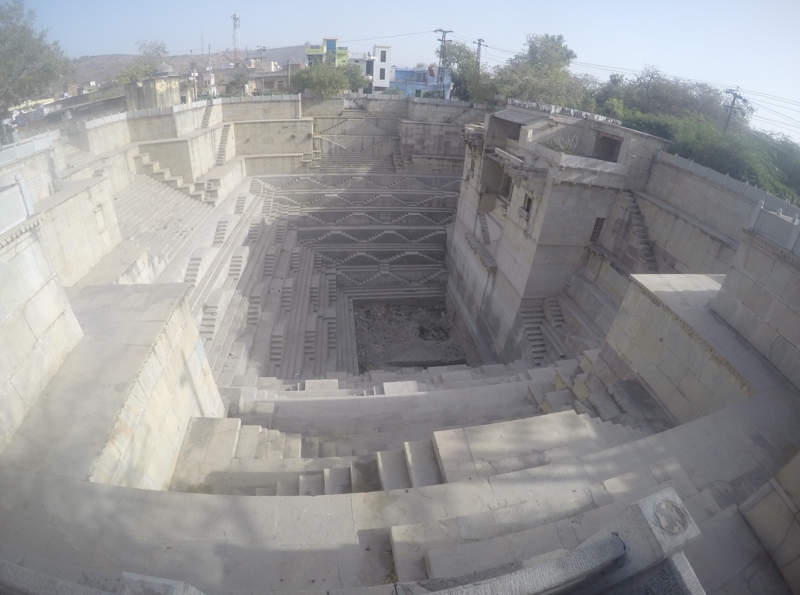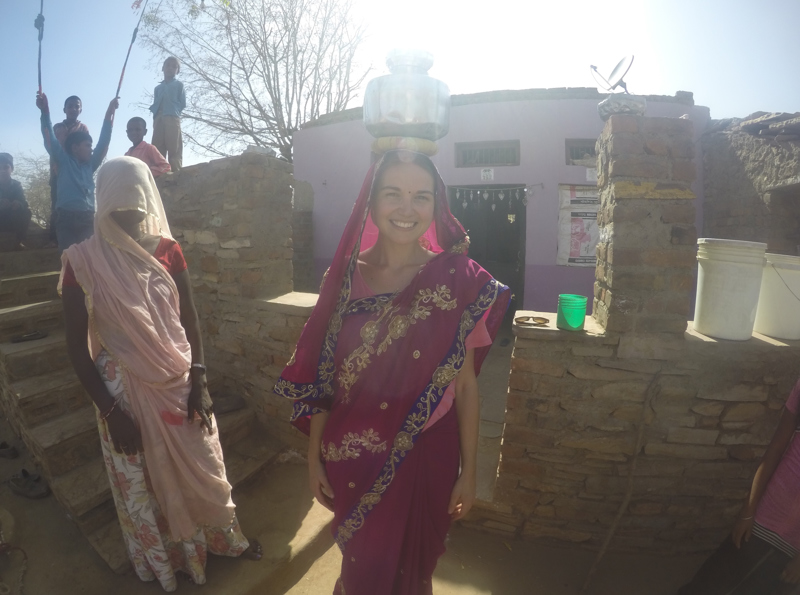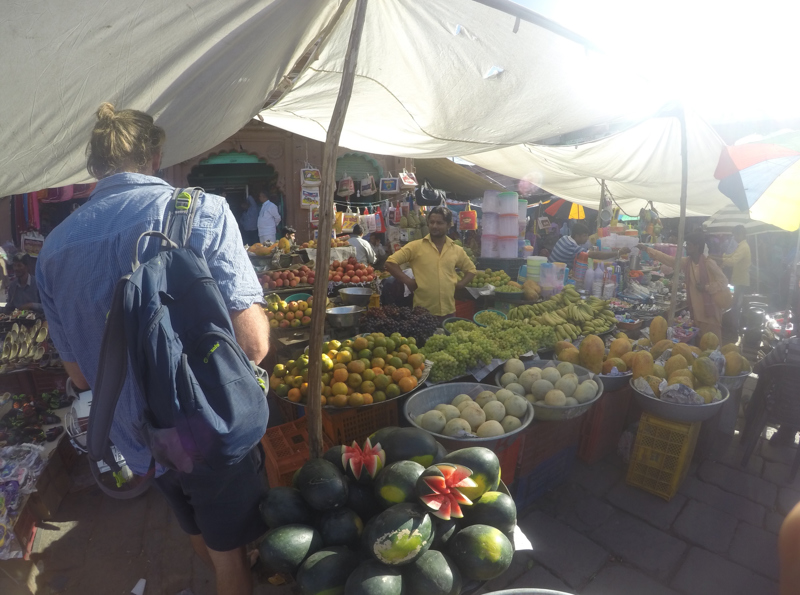India, Europe and Africa 2016
After talking with a few locals and other tourists about their favourite places in Rajasthan, and not feeling like we'd got quite far enough away from the tourist hassle in Pushkar, we decided to change our plans and head to Bundi. Bundi is southeast of where we were and there were no trains, so after catching a bus from Pushkar to Ajmer, we boarded a 5 hour bus to Bundi. There was virtually no one else on the bus initially, and we were feeling relaxed. Unfortunately, letting our guard down for the first time in the trip cost us when the bus filled up and our camera was stollen from by bag in the hanger above us. Within minutes the situation drew attention from all over the square, with multiple reenactments of the scene in Hindi and much serious discussion. Though probably enjoying the drama, especially with a couple of foreigners at the centre of it, it was comforting to see how angry some of them seemed about it. Someone took us to the nearby police station where we naively expected to spend an hour or so getting a police report for insurance. For the next 2 hours, Liam sat in the back of a mahindra with three policemen ‘searching’ for the thief, who would obviously be walking around town with our camera over his shoulder. After the fourth leisurely stop to consume peanuts and smoke cigarettes, Liam was sure they were heading back in the direction of the station. His exasperation reached its peak when he realised that though they were indeed going to the station, they weren't planning on stopping at it. Trying to make sense of what was going on, the only English word he could get out of them was ‘commando’. They proceeded to pick up an undercover cop to drop off at the bus station, presumably because they thought there was no
emily.j.buswell
30 chapters
16 Apr 2020
Pushkar to Bundi
Bundi
After talking with a few locals and other tourists about their favourite places in Rajasthan, and not feeling like we'd got quite far enough away from the tourist hassle in Pushkar, we decided to change our plans and head to Bundi. Bundi is southeast of where we were and there were no trains, so after catching a bus from Pushkar to Ajmer, we boarded a 5 hour bus to Bundi. There was virtually no one else on the bus initially, and we were feeling relaxed. Unfortunately, letting our guard down for the first time in the trip cost us when the bus filled up and our camera was stollen from by bag in the hanger above us. Within minutes the situation drew attention from all over the square, with multiple reenactments of the scene in Hindi and much serious discussion. Though probably enjoying the drama, especially with a couple of foreigners at the centre of it, it was comforting to see how angry some of them seemed about it. Someone took us to the nearby police station where we naively expected to spend an hour or so getting a police report for insurance. For the next 2 hours, Liam sat in the back of a mahindra with three policemen ‘searching’ for the thief, who would obviously be walking around town with our camera over his shoulder. After the fourth leisurely stop to consume peanuts and smoke cigarettes, Liam was sure they were heading back in the direction of the station. His exasperation reached its peak when he realised that though they were indeed going to the station, they weren't planning on stopping at it. Trying to make sense of what was going on, the only English word he could get out of them was ‘commando’. They proceeded to pick up an undercover cop to drop off at the bus station, presumably because they thought there was no




way the offender would be from their own village, so he would be trying to catch a bus out of town. Finally, Liam joined me back at the station and 3 hours after we arrived we got our paperwork. That said, I'm really not sure what the insurance company is going to do with a police report in Hindi.
Though our spirits weren't as high as they had been, Bundi turned out to be one of our favourite spots. Being a small town out of the way without any really well known sites, it sees far less tourists and so is relaxed and very low-hassle. The most characteristic feature of the town are the numerous step-wells, known as baoris. There are a handful of maintained and well known ones, but over a hundred in total. With no nearby river, previous Maharajas have had these incredible wells constructed to provide water for drinking, washing, cooking and swimming to villagers. The biggest wells are at least 20m deep and 50m wide, lined by a series of steps down to the water on each side. Some of them did have quite a bit of water in them even at this time in the year, when it hasn't rained for months, others were bone dry. I did wonder how they might get a stray cow out if she wandered into one for a drink.
The second distinguishing feature of Bundi is the blue colour all the houses are painted in the town. In the past, Brahmins (the highest Indian caste) painted their homes blue so that they could be easily discerned from other castes. Since then the blue paint has been adopted by, and made compulsory for most of the town because it is supposed to repel insects, and keep the houses cool in the 40-50 degree heat of the summer. Jodhpur, the second biggest city in Rajasthan also paints their buildings blue, however one of Bundi’s residents sternly pointed out that Jodhpur blue is darker, definitely not to be confused with the alluring light blue which makes Bundi so beautiful. Indians pride for their cities and their country, is generally admirably strong. Some would say they have their priorities skewed however, as although they take the colour of their houses very seriously, the small lake in the centre of Bundi is a stagnant thick green soup, full of rubbish.
We spent a morning up at the Taragarh Fort, towering high above the town. Heading off quite early, we soon found it was quite a trek up to entrance from the ticket gate. Half way up, a small Indian man scurried past us, almost running. He seemed to have such purpose, we wondered what could be so important at the top of the hill. Reaching the fort gate he jumped out at us with a stick and in very very rapid English gave us 20 reasons why we needed him as our guide for the morning. Hadn't we heard that the fort monkeys were dangerous?! Hadn't we heard it was like an impenetrable jungle up there?! Not only was he a guide, he proclaimed, he knew lots of jokes! The tipping point for us however was the very tatty page he found in his pocket with two tourist endorsements of the quality of his services. One was in French and the other in Hindi, but very kindly he translated them for us.
The fort was built in 1354 the maharaja at the time and . With no protection or restoration, it was very different from all of the other forts we've visited. The only sound was the jingle of bells on goats browsing the overgrown paths and gardens, previously occupied by kings. Curiously, the raw reality of what it has become made it easier to reflect on what its previous magnitude and splendour. As well as this, our very passionate guide was very good at making the place come to life, showing us small details like messenger pigeon boxes and elephant tethering sites, that we would have otherwise missed.
The view over town onto the blue houses and small lake was great and back towards a natural lake where the locals describe a ‘Mowgli house’, a place where Rudyard Kipling supposedly spent time getting inspiration for his writing.
We organised a day with a local archeologist, Kukki, who has done a lot of exploring in the area discovering and documenting cave paintings. His enthusiasm was infectious and his care about the wildlife and environment was heartening, given that in India you constantly feel like you are witness to lack of recognition of the effects of littering, pollution and the environment. His theory on the paintings and diagrams of animals and people, traps and hunting were once created for education within tribal groups. As well as paintings he showed us large canyons, the only lush areas for miles around. At one swimming hole we saw three different types of kingfisher. Until . Hunted heavily first by the maharajas and then the raj, accompanied with habitat destruction, they became extinct in the area. Since becoming protected in the 1970’s they are making a comeback in the nearby Ranthambore national park.
Holding our bags tightly, we left Bundi for a very bumpy bus ride to Ajmer, followed by a hot and very full train ride to Jodhpur. We were amused at the end when Liam was asked to fill out a train service feedback form. Of course he had to sign his name but leave the feedback part blank so they could write a glowing report for themselves.
1.
Kolkata to Darjeeling
2.
Darjeeling
3.
Darjeeling to Kurseong
4.
Kurseong to Varanasi
5.
Varanasi to Khajuraho
6.
Khajuraho to Agra
7.
Agra to Jaipur
8.
Jaipur to Pushkar
9.
Pushkar to Bundi
10.
Bundi to Jodhpur
11.
Jodhpur to Jaisalmer
12.
Jaisalmer to Delhi
13.
Delhi to London
14.
London to Waterford
15.
Waterford to Tralee
16.
Tralee to Westport
17.
Westport to Mullingar
18.
Mullingar to Donegal
19.
Donegal to Belfast
20.
Belfast to Dublin
21.
Dublin to Berlin
22.
Berlin to Marburg
23.
Marburg to Munich
24.
Munich to Salzburg
25.
Salzburg to Ljubljana
26.
Ljubilana to Lake Bled and Postojna
27.
Postojna to Croatia part one
28.
Croatia to Bosnia-Hercegovina
29.
Bosnia to Croatia part 2
30.
Croatia to Italy